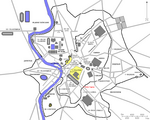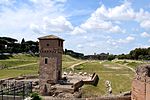Arch of Titus (Circus Maximus)
1st-century establishments in Italy80s establishments in the Roman EmpireAncient Roman triumphal arches in RomeBuilding projects of the Flavian dynasty

The lesser-known Arch of Titus was a triple bay arch erected at the eastern end of the Circus Maximus by the Senate in A.D. 81, in honour of Titus and his capture of Jerusalem in the First Jewish–Roman War. Few traces remain. The inscription (CIL 19151=ILS 264), quoted by an 8th-century Swiss monk known only as the "Einsiedeln Anonymous", makes it clear that this was Titus' triumphal arch. Sculptural fragments of a military frieze have been attributed to the arch.Architectural and epigraphic fragments of the now lost arch were rediscovered during excavations in 2015.
Excerpt from the Wikipedia article Arch of Titus (Circus Maximus) (License: CC BY-SA 3.0, Authors, Images).Arch of Titus (Circus Maximus)
Via del Circo Massimo, Rome Municipio Roma I
Geographical coordinates (GPS) Address Nearby Places Show on map
Geographical coordinates (GPS)
| Latitude | Longitude |
|---|---|
| N 41.884444444444 ° | E 12.488333333333 ° |
Address
Circo Massimo
Via del Circo Massimo
00153 Rome, Municipio Roma I
Lazio, Italy
Open on Google Maps









